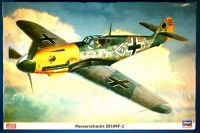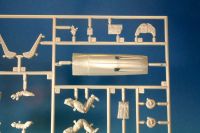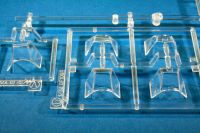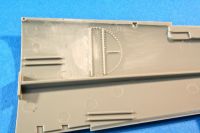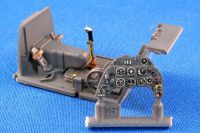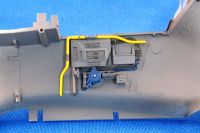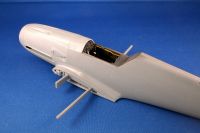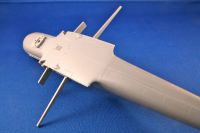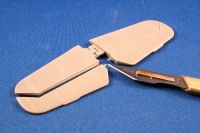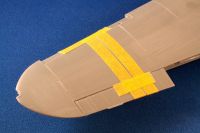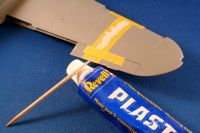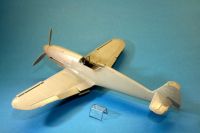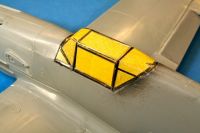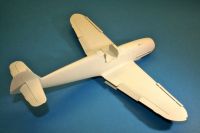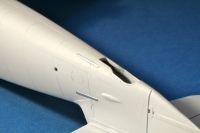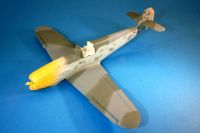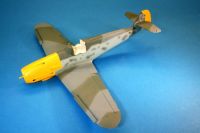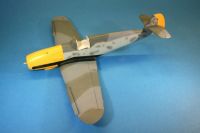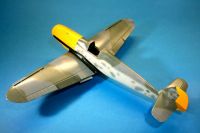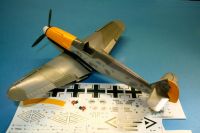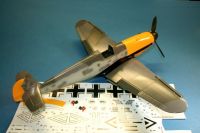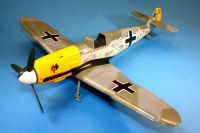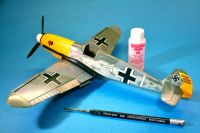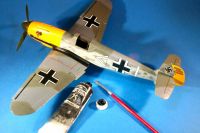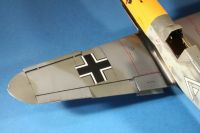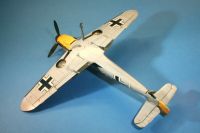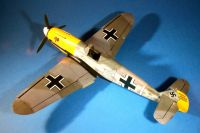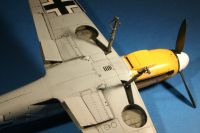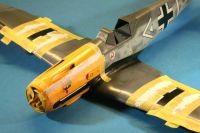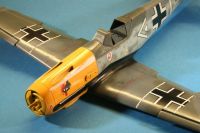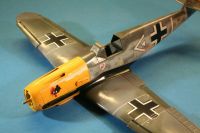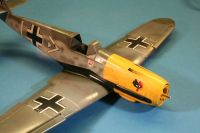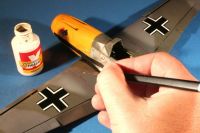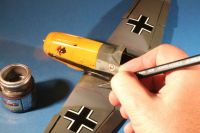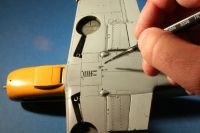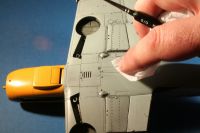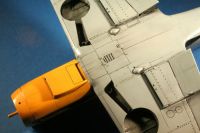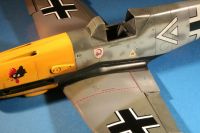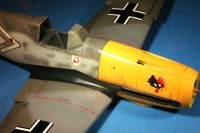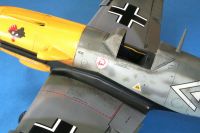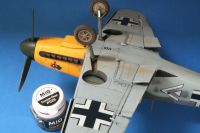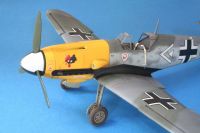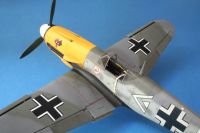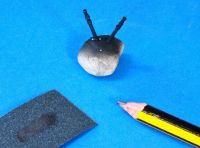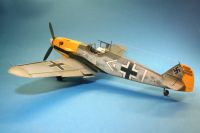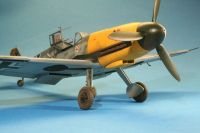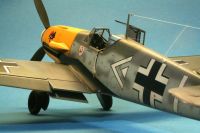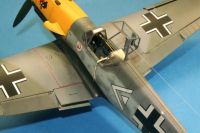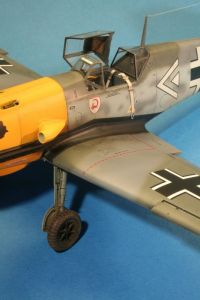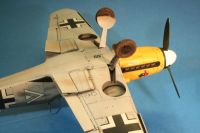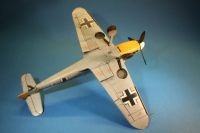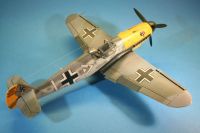Hasegawa 1/32 Messerschmitt Bf 109F-2
By Iain Ogilvie
Building Hans “Assi” Hahn's Bf 109F-2
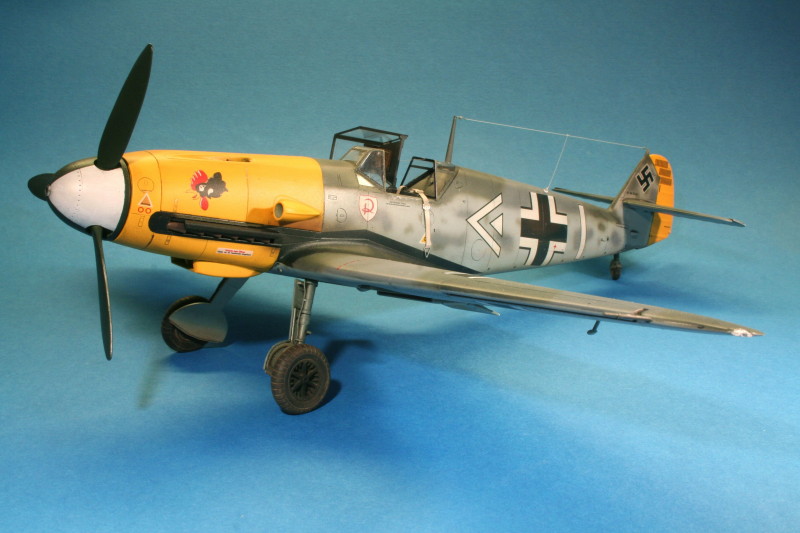
What’s in the box?
In addition to the changes Hasegawa have made to the mouldings to reflect the Freidrich model, they’ve also taken the opportunity to refine some of the original Gustav components such as the propeller spinner, which now has a far more prototypical shape. Compared to the earlier kits, and common to their other ‘F’s, the main fuselage mouldings now have the tail sections moulded in, rather than separate components, and the general finesse and detail provided by the new components is superior to the earlier ‘G’s and ‘K’s, an example being individual exhaust pipes. Use is made of slide moulds, with things like gun barrels having moulded indentations at their muzzles.
The wing sections are unchanged from the earlier kits though, and require several areas of surface detailing to be filled by the builder to accurately portray the F-2 variant. Inserts are provided to fill the dished areas found in the wheel wells on the earlier kits. The wheels are of the correct type and beautifully rendered, with separate tyres and hubs.
Four self-adhesive etched metallic strips are included to replicate the rear fuselage strengtheners found on many F’s, and no less than five styles of windscreen are supplied, with options for separate internal and external armoured glass. The plastic mouldings even feature the pilot’s hand-holds on the top corners of the windshield. The cockpit has been re-done to correctly portray the ‘F’ and, again, the opportunity has been taken to provide a little more detail, with things like the fuel piping on the right hand side as a completely separate part. A pilot figure is provided in ‘flying’ pose with a choice of three heads to suit your taste.
Decals are nicely printed and provide markings for three airframes: two flown by Kommandeur Hauptman Hans “Assi” Hahn III./JG2 in July 1941 and a third aeroplane flown by Kommodore Oberstleutnant Günther Lützow of III./JG3 in October 1941. The decal sheet also includes instruments and seat straps, although the latter are never particularly convincing as decals. Swastikas are included in the UK boxing.
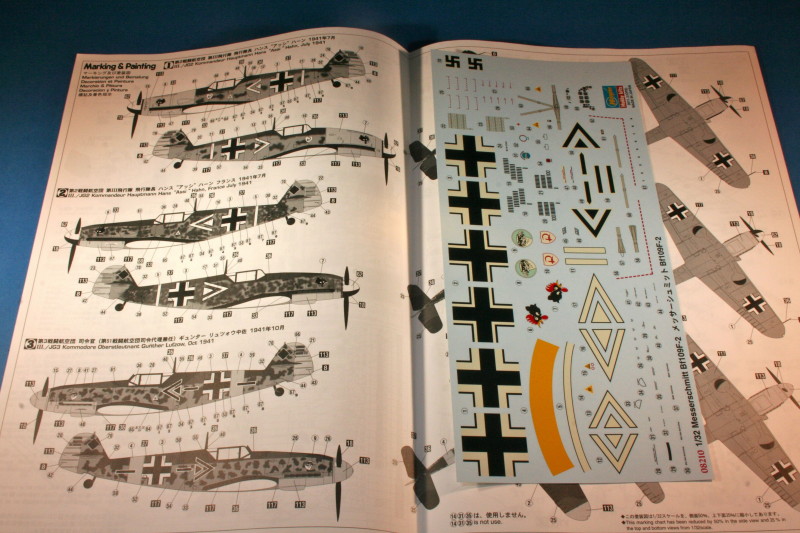
Taken by the striking box art image of Hahn’s yellow nosed Werk Nummer 5749 I just had to crack on – for once choosing a scheme was easy!
I’ve built a fair few of Hasegawa’s 109 kits since the G6 was released almost 10 years ago, so I’ve developed a build process that doesn’t always follow the construction sequence outlined by Hasegawa in their instructions.
First off - looking at some subtle changes that need to be made to various areas of surface detail to accurately represent the F-2 version of the 109. The areas to be addressed are all identified in the instructions, with the exception of some additional panel lines on the wing upper surfaces that need removing - we’ll discuss that later. My filler of choice here was Revell’s Plasto - applied sparingly after tape masks had been strategically placed around the relevant areas to minimise the sanding-back process that was undertaken a few days later. Note that whilst some early 109Fs had ‘squared-off’ gear bays, Hasegawa’s instructions correctly portray the round type fitted to Hans ‘Assi’ Hans particular 109F-2 and backed up with clear photo’s found on the net - see ‘Links’ at the end of the article.
Inside the gear bays a pair of moulded ‘filler’ pieces are provided to correctly portray the flat upper sections inside. The fit here was never going to be easy and I found some patient fitting, filling and sanding was the order of the day - with a little subsequent loss of peripheral detail.
Office work...
Onto the cockpit and here Hasegawa have correctly portrayed that of the ‘F’ model. As I wanted to see what the model would look like built almost straight from the box I simply assembled the pieces and painted - with the addition of rudder pedal straps from masking tape. Paints are mainly Lifecolor as I rather like them for this kind of work. Now - instrument panel: what you see here is the kit panel exactly as moulded, sprayed RLM66 followed by a couple of coats of Quick Shine varnish and the kit instrument decal applied - followed by a generous application of Micro Sol decal softening solution. With care taken to align the instrument designs on the decal with the moulded detail on the panel the Micro Sol does a brilliant job of pulling the decal down into and over the moulded detail. With an overall coat of Xtracrylix mat varnish and the bezels picked out using a small brush and some more Quick Shine I think the results straight from the box are pleasing enough. Cockpit assembly continued - with a little strategic application of Flory Models excellent weathering wash to ‘pop’ a little detail.
After the cockpit, assembly proceeds rapidly: these really are straightforward kits and a great introduction to larger-scale modelling. Fuselage together, cowling port side insert carefully installed (fits like a glove) and top cowl section added. The smooth lines of the Freidrich are starting to appear! Fit of the fuselage and cowl sections really is very good - but you’ll see later that another mistake was made with regard to panel lines!
A particularly neat feature of Hasegawa’s 1:32 109 range is the neat and simple way the wings are attached and the correct dihedral set. The under-fuselage section is provided as a separate part - to which a single part ‘spar’ is bonded - before fitting the assembly to the fuselage. It’s a very simple solution that just works!
From here on construction is an absolute breeze. Wing upper and lower halves are joined after adding the radiator sections and assembly onto the fuselage is straightforward - with a nice clean joint and perfect dihedral.
Tail planes. As moulded in the kit the shapes are excellent, but I always feel that a little ‘animation’ of control surfaces always adds character to a model and most photo’s of 109s show the elevators displaced to some degree, or other. Separation is simple - a few passes top and bottom with a fresh blade and the elevators can be snapped away from the tail planes, cleaned up, and re-affixed once the tail planes have been fitted. As part of Hasegawa’s ‘keep it simple and effective’ approach - the two sides of the tail plane interlock - ensuring perfect alignment. Just place in position and run some liquid cement into the joint.
Another fill!
At this stage attention was paid to the panel line on the upper surface of the main plane that needs filling for the ‘F’ variants and is shown on the kit instructions - but note there’s a potential ‘gotcha’ there on early aircraft - more later. After masking close to the line, the area was filled with Revell Plasto filler and the surface sanded back and restored before fitting the slats. The slats on the 109F slid in and out freely and can be seen either open, or closed (and even closed one side, open on the other) on aircraft on the ground - so the choice of deployed or not is down to the builder.
Ready for the spray shop...
With elevators bonded in position it doesn’t take long to get the rest of the control surfaces fitted to the wing, assemble the propeller (with it’s more accurate shape compared to Hasegawa’s earlier kits) and fit the front and rear canopy sections relevant to this version after going around their edges with a black permanent marker (Sharpie) to reduce internal reflections. Clear components were bonded in place, after dry-fitting, using Plastic Weld liquid solvent. At this stage the main undercarriage legs have been prepped and are simply dry fitted in position to give the model something to stand on. Starting to look like a 109F!
Canopy masked up with my favourite tape - Tamiya - and the fit of the opening portion checked. Whilst I was going to pint some of the internal sides of the canopy frames in RLM66 in the final stages of the build, it’s always worth ‘priming’ the framework from the outside with the colour you would see from the inside - so canopy sprayed with RLM66 before coating the whole airframe in Halfords White Primer from an aerosol to check for flaws and provide an ideal base for that large area of yellow on the nose!
With a few minor flaws found and corrected we were now ready to add the photo-etched strengthening plates to the area where the tail joins the main fuselage. This is simplicity itself as they are provided free of any frames to be removed from and are self adhesive. I loosely put in place, aligned with the tip of a scalpel blade, and pushed ‘home’ with a finger once correct positions established.
Getting colourful
After masking off the cockpit opening we were now ready for colour it made sense to start with the yellow - in this case Xtracrylix RLM04 - on the nose and the rudder. I like airbrushing these paints and simply thin with a little tap water and Winsor and Newton Acrylic Flow enhancer. After a three separate, thin, coats to build up the colour density the model was put aside for a few hours before masking off the nose completely with Tamiya tape along the cowling panel lines, and the rudder along it’s hinge line.
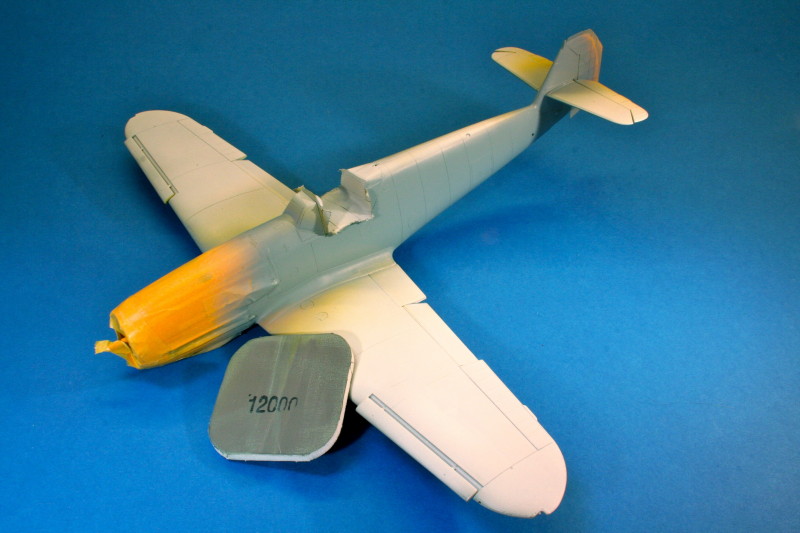
Next up - a couple of coats of Xtracrylix RLM76 over the undersurfaces and fuselage sides. Again, the model was left a few hours before cracking on with the upper surface colours - sprayed freehand using Aeromaster RLM74 and RLM75 - with my trusty Iwata HP-CH following the demarcations illustrated in the Hasegawa instructions. I used Aeromaster for these colours as I quite like the faded tones of these paints.
Final stage in the main painting session was the prominent black areas along the cowl around the exhaust stacks and along the wing roots - presumably to ‘neaten’ the area where exhaust staining would have been most prevalent. Referring to the box art, the instructions, and photo’s of the real aeroplane this area was carefully masked off. What I did notice from the original photo was a rounded section to the black at the front of this area on each side - so the area was masked to suitably re-create this feature. After a couple of light passes with the airbrush filled with Tamiya flat black all of the masking was removed from the airframe (but not the canopy) - always a nerve wracking stage but in this instance everything looked clean and sharp.
In preparation for decals the model was given two coats of QuickShine, decanted into the airbrush straight from the bottle as I find this material sprays beautifully and performs far better than Future/Kleer as a varnish.
Properly dressed!
With the model left 48hrs for everything to harden it was time for the decals which, in the majority are straight from the kit with the exception of the upper-wing crosses. The latter I had to replace - I applied the kit ones only to have them ‘stick’ in a slightly skewed position and have them break when I tried to correct. With the rest of the decals I made sure they were floated onto a nice puddle of water so that any tweaks to position could be achieved after laying on the surface. Micro Sol was used to help give the markings that ‘painted-on look and, I have to say, apart from my initial glitch, they were superb. Perfect register, opaque and settling down into detail beautifully, with no visible carrier film.
Under the weather...
With decals allowed to dry and any excess decal ‘glue’ washed off the model, it was time to start the fun part - making it look less like a model and more like a ‘shrunk’ original.
On WWII types I prefer to use oil paints along joints (more modern types I tend to use Flory Models washes). This is applied directly from the tube, area by area, and polished away using kitchen paper and, in some area, cotton buds, until there’s just a hint of the oil pain left. Remember - less is more: it’s very easy to overdo weathering in some instances and images showed this aircraft to be in pretty clean condition when it wore this scheme (it would, after all, have been fairly new!). At this stage I also added some very subtle wear to the leading edges of the prop.

Oh dear...
It was towards the end of this process I realised I’d made a mistake! I has assumed the horizontal joint between the top cowl section and the sides was a panel line in real life but, checking photo’s and asking questions over on Britmodeller, it became apparent that there was no such panel joint! Argh! This was exactly the wrong stage for this to happen, with the nose neatly painted and the cockerels head markings of ‘Assi’ Hahn’s plane already fitted and no source of spares. Not only that, but the topic of upper wing panel lines on 109F-2s came up; current research indicating that early aircraft had no upper surface joints in the skin. I was skeptical at first, but a little online research dredged up some images that appeared to support this. I’m not sure if this means that some early aircraft had a single upper skin, or whether the joints were initially filled for performance gains which were later found negligible. Whatever the reason, I decided to apply this to my model although I cannot vouch for this being correct for this particular airframe.
After much hair pulling, and a wee glass of Laphroaig, I bit the bullet and carefully masked off the relevant areas to be filled with tape and Maskol before very carefully filling and sanding with a fine sanding stick and Micromesh. Hopefully the photos illustrate what had to be done. The cowl markings faired amazingly well with no damage, but the wing crosses could not be saved.
With panel lines removed, the wing crosses polished back and the cock’s heads masked with Maskol, the yellow nose and camouflage sections were restored and re-varnished and a third set of crosses added to the upper wings. After a lot of stress you could hardly see what had gone wrong!
Back to going forwards!
Detail weathering; fine chipping around worn areas, cowl fasteners and access panels was applied in grey and silver using a 00000 brush, followed by localised staining applied in oils. Underside streaks - where oils and fluids leak and get drawn back in the airflow - are done by adding spots of oil paint with a small brush and ‘smudging’ backwards with kitchen paper. At this stage I also added some subtle exhaust staining. For this I have a favourite very dark ready-brown mix of acrylic paint, clear varnish, tap water and a little flow enhancer that can be misted on gently with the airbrush and the effect built up until it creates the right effect. On this model it’s subtle; you should just pick up some staining around the bottom of the yellow cowl areas in the photos.
Bits and pieces...
With the model finally coming together it was time to prep some ancillaries; undercarriage, seat and exhaust stacks. The kit seat has been used - painted RLM66 and suitably chipped and weathered around it’s edges. Exhaust stacks are made up from individual components and look good assembled - a quick coat of my ‘exhaust’ mixture and the shield sections were added before affixing to the model. The wheels provided are excellent in my opinion - with separate tyres and hubs - the latter being nice and deep. Now - can anyone spot the deliberate mistake at this stage? No? We’ll come back to it at the end...
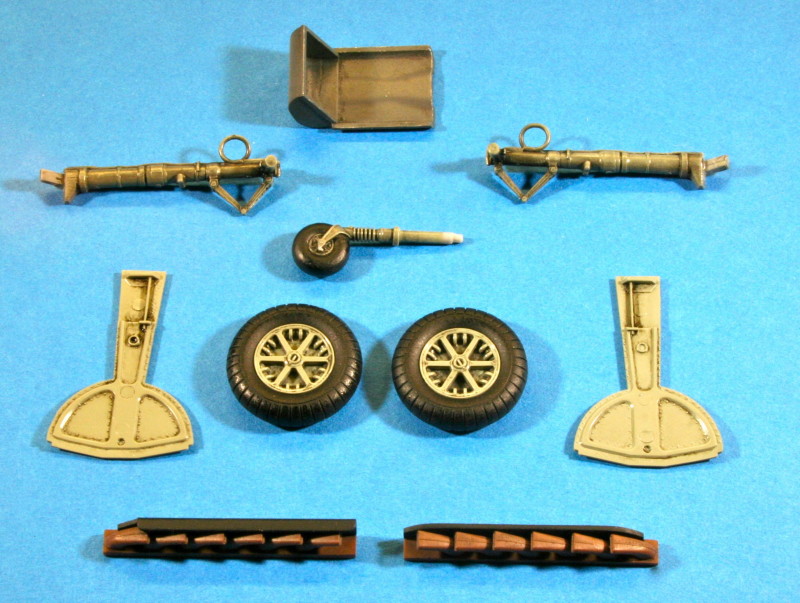
The gear legs are neatly done - with separate scissor links and brake pipe sections. A quick coat of RLM02 grey was followed by a black oil wash and the addition of polished olio sections made from Bare-Metal foil. This is thin aluminium foil that has a self adhesive backing and is ideal for wrapping around the olio section on aircraft undercarriage.
Now, at the beginning I did say I was going to stay pretty much with what was supplied in the box for this build but one thing I did add was a set of the excellent pre-coloured photo-etch strap sets from Eduard. Although fiddly to assemble I think the results are worthwhile.
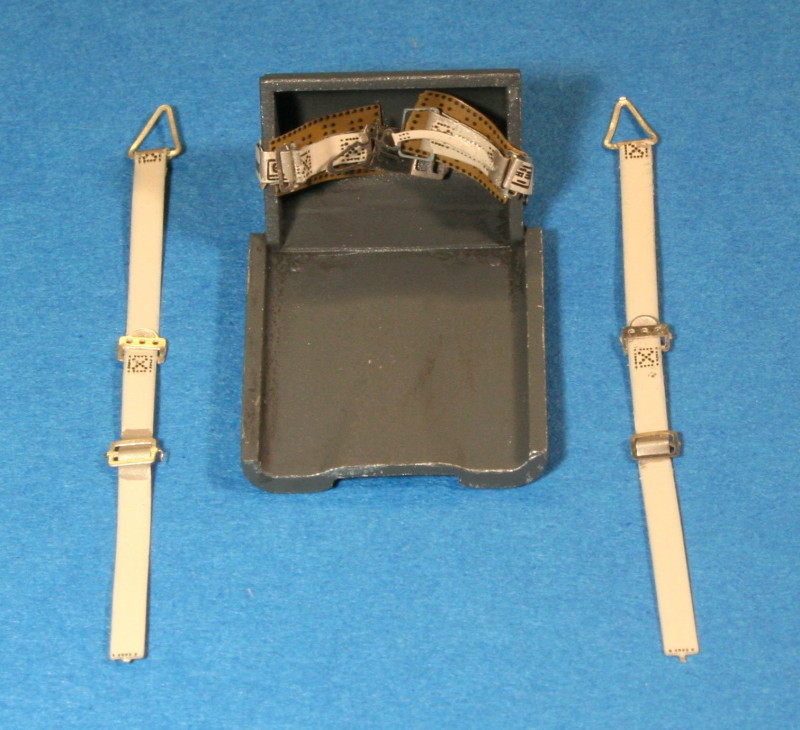
Photo 68
Mud and boots
Last stages of weathering were the addition of some ‘boot’ marks on the port wing root and some dust and dirt around the undercarriage, wings and rear fuselage. For the former I used a tinting technique - again using oil paint applied as dots and smudged-in with kitchen paper.
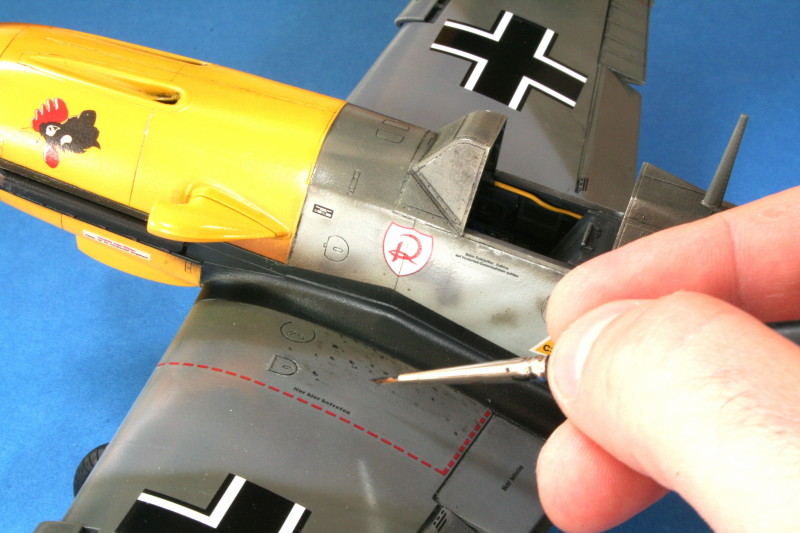
The dust and dirt was added using MiG Weathering powders and, I have to say, I’m becoming quite a fan of these! Using a soft brush the powder was built up on the tyres, wheels, gear legs, areas behind the gear bays where mud and soil would have been thrown up on landing, tail-wheel and the lower rear fuselage. Once built up to the desired level it can be sealed in with varnish - in this case an overall coat of Xtracrylix matt varnish over the whole model.
Final details
With the final coat of varnish on it was time to add final details. The seat was added to the cockpit, with one of the straps nonchalantly draped over the side to provide a little more animation to the model. The gun sight provided was painted, assembled and fitted. The guns were finished using an old technique that provides a fairly realistic finish: simply paint matt black and then rub with powdered pencil lead made by rubbing a pencil on a suitable abrasive sheet.
Aileron mass balances added and canopy check-strap and aerials made from stretched sprue.
One final fix!
That was about it but, if you remember my comment earlier about the wheels? I’d assumed from the photo I had to hand that the hubs on this were RLM02 grey as that’s what the photo appeared to show. However 109 family wheels where black as standard and a later photo of the same airframe that someone kindly posted on the forums for me clearly showed it black. So another brave moment in the build as I cut some masks from tape using a compass cutter and carefully re-spray in situ!
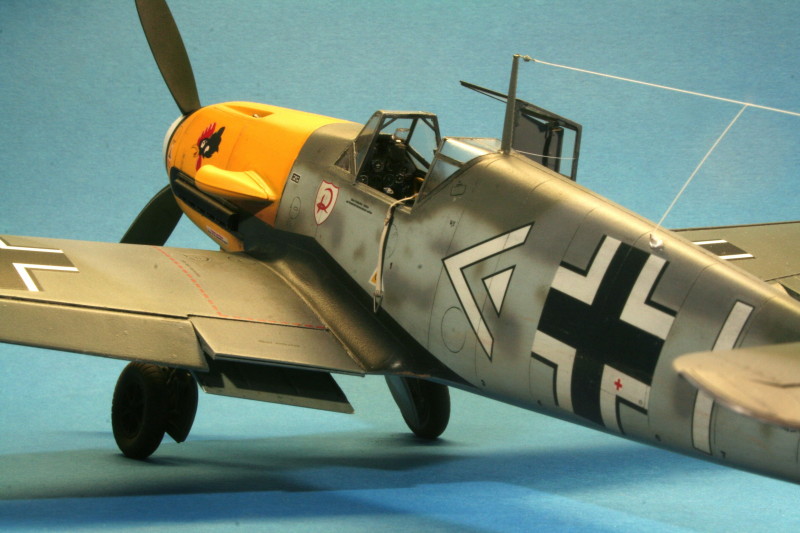
Conclusion
This is another lovely 109 from Hasegawa and probably their nicest yet. I love the lines of the ‘Friedrichs’ and this scheme suits it perfectly. Whilst the ‘G’ and ‘K’ kits were nice, the ‘F’ series kits are definitely a step up, although some of the detail changes that need to be made to the original ‘G’ series parts to produce an ‘F-2’ are a little tedious. It’s unfortunate that Hasegawa kits are so expensive now here in the UK. I’ll give it top marks for subject and quality, but would have to say it’s down to the individual with regards to value for money.
Despite a few ‘gotchas’ on the way I really enjoyed this one.
References
Good front ¾ view of this machine/scheme:
http://old.messerschmitt-bf109.de/pics-bf109f/bf109f2_061-swfoto.jpg
Materials
- Paints – mainly Xtracolor and Aeromaster acrylics
- Gloss Cote – Quick Shine
- MiG Weathering Powders
- Flory Models Wash
- Acrylic Flow Enhancer - Winsor and Newton
- Oil Paint – Winsor and Newton
- Fillers – Revel Plasto
- Airbrush – Iwata HP-CH
Happy Modelling!
Iain
© Iain Ogilvie 2013
This article was published on Thursday, December 12 2013; Last modified on Tuesday, December 31 2013

